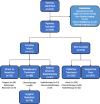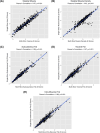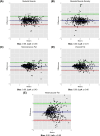Comparison Between Single- and Multi-slice Computed Tomography Body Composition Analysis in Patients With Oesophagogastric Cancer
- PMID: 39723572
- PMCID: PMC11669944
- DOI: 10.1002/jcsm.13673
Comparison Between Single- and Multi-slice Computed Tomography Body Composition Analysis in Patients With Oesophagogastric Cancer
Abstract
Background: Single-slice computed tomography (CT) body composition has been studied extensively for prognostication in patients with cancer. New software packages can also provide multi-slice volumetric measurements, but the clinical utility of these remains under explored. This study aimed to evaluate the agreement between single- and multi-slice body composition analyses in patients with oesophagogastric cancer and to explore the association between these measures and overall survival.
Methods: Consecutive patients with newly diagnosed oesophagogastric (OG) cancer were identified through the prospectively maintained regional database of the South East Scotland Cancer Network across a 2-year study period. CT body composition analyses were undertaken using scans collected during routine clinical care. Single-slice (cross-sectional area at mid L3) and multi-slice (volume between T12 and L4) measurements were compared for skeletal muscle (SKM), subcutaneous adipose (SAT), visceral adipose (VAT) and intermuscular adipose (IMAT). Agreement between sex-stratified z-scores was quantified using Pearson correlation coefficients and Bland-Altman analyses. Cox proportional hazard modelling was used to estimate the effect of these measures on overall survival.
Results: Overall, 504 patients (67.9% male, median 72 years) were newly diagnosed with OG cancer during the study period. Single- and multi-slice (mean: 169 slices) measurements correlated highly for SKM (R: 0.97, p < 0.001), SAT (R: 0.98, p < 0.001), VAT (R: 0.97, p < 0.001), SKM radiodensity (R: 0.93, p < 0.001) and IMAT (R: 0.88, p < 0.001). Bias on Bland-Altman analysis was 0.00 for all tissue measurements. Limits of agreement (LoA) were narrowest for SAT (±0.43), VAT (±0.46) and SKM (±0.48), but slightly wider for SKM radiodensity (±0.73) and IMAT (±0.96). Adipose tissue 'outliers' (those where agreement between single- and multi-slice z-scores was outside the LoA) had a higher median weight and body mass index (BMI), suggestive of poorer agreement in patients with obesity. Sensitivity analysis, excluding those with BMI > 30, narrowed the LoA for SKM, VAT, SAT and IMAT. Direction and magnitudes of observed effect sizes for overall survival were all highly comparable, with hazard ratios for each tissue type varying by ≤ 0.04 between single- and multi-slice adjusted estimates.
Conclusions: Single-slice and multi-slice CT assessments provide highly correlated tissue measurements amongst patients with OG cancer. Associations between these measurements and overall survival were also comparable across both types of body composition analysis. Agreement between single- and multi-slice measurements of adiposity is worse in patients with obesity, suggesting single-slice analyses may less accurately reflect the quantity or distribution of adipose tissue in this patient group.
Keywords: body composition; cachexia; gastric cancer; oesophageal cancer; survival.
© 2024 The Author(s). Journal of Cachexia, Sarcopenia and Muscle published by Wiley Periodicals LLC.
Conflict of interest statement
Leo R. Brown, Maria Soupashi, Michael S. Yule, Danielle R. Clyde, Ellen Gardner, Charlotte Smith, Ahmed Dhaif and Stephen J. Wigmore declare no conflicts of interest. Richard J.E. Skipworth has received personal fees for consultancy from Avidity Biosciences, Actimed, Faraday and Helsinn. Barry J.A. Laird has received personal fees for consultancy from Artelo, Actimed, Faraday, Kyona Kirin and Toray.
Figures





References
-
- Shachar S. S., Williams G. R., Muss H. B., and Nishijima T. F., “Prognostic Value of Sarcopenia in Adults With Solid Tumours: A Meta‐Analysis and Systematic Review,” European Journal of Cancer 57 (2016): 58–67. - PubMed
-
- Aleixo G. F. P., Shachar S. S., Nyrop K. A., Muss H. B., Malpica L., and Williams G. R., “Myosteatosis and Prognosis in Cancer: Systematic Review and Meta‐Analysis,” Critical Reviews in Oncology/Hematology 145 (2020): 102839. - PubMed
-
- Jogiat U. M., Sasewich H., Turner S. R., et al., “Sarcopenia Determined by Skeletal Muscle Index Predicts Overall Survival, Disease‐Free Survival, and Postoperative Complications in Resectable Esophageal Cancer: A Systematic Review and Meta‐Analysis,” Annals of Surgery 276 (2022): e311–e318. - PubMed
-
- Kamarajah S. K., Bundred J., and Tan B. H. L., “Body Composition Assessment and Sarcopenia in Patients With Gastric Cancer: A Systematic Review and Meta‐Analysis,” Gastric Cancer 22 (2019): 10–22. - PubMed
MeSH terms
Grants and funding
LinkOut - more resources
Full Text Sources
Medical
Research Materials
Miscellaneous

